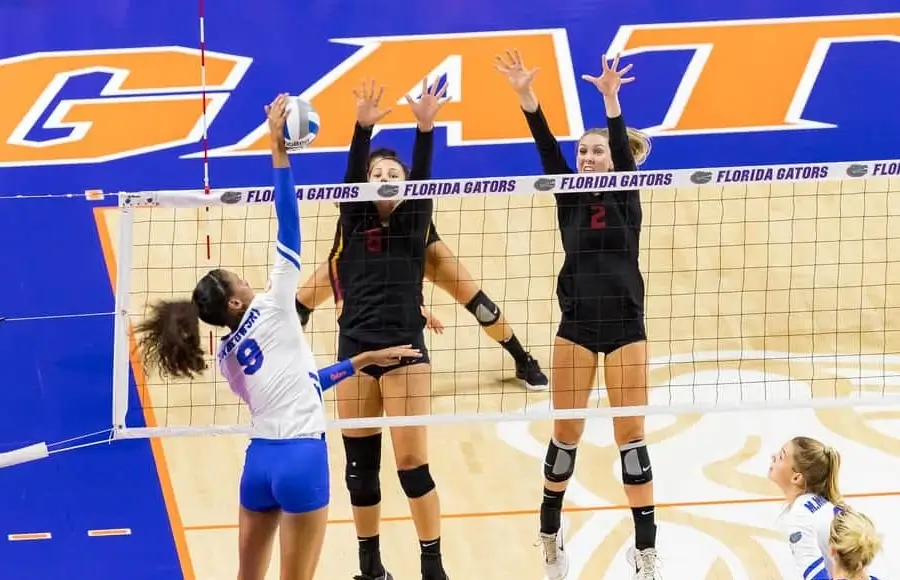Last Updated: October 19, 2023
There are many different angles of attack for volleyball spiking. That said, the angle of attack for a spike is largely influenced by a player’s skillset and experience.
Less-experienced players usually plan their offensive strategy before the play commences. On the other hand, experienced players make decisions on the court based on game situations.
Players with the necessary ability, experience, and situational awareness to make last-minute changes in their offensive strategy have higher chances of scoring points.
Below are some techniques for spiking (or hitting) from different angles using various strategic attack options.
Techniques for Spiking from Different Angles

Cross-Court
To execute effective cross-court spike shots, you must hit the ball diagonally to the other side of the net to exploit gaps or vulnerabilities in the opposing team’s defense. Cross-court volleyball spiking requires proper technique, timing, and game awareness.
Using a Straight-on Approach to Execute Shallow Cross-Court Shot
 For the shallow cross-court shot directed near the net or in front of the blockers, you must use a relatively straight-on approach. The approach angle should be more towards the net and less diagonal.
For the shallow cross-court shot directed near the net or in front of the blockers, you must use a relatively straight-on approach. The approach angle should be more towards the net and less diagonal. You should connect with the volleyball slightly in front of the hitting shoulder. After connecting with the ball, the follow-through needs to be diagonal towards the intended target area.
You should connect with the volleyball slightly in front of the hitting shoulder. After connecting with the ball, the follow-through needs to be diagonal towards the intended target area.
When executing a shallow cross-court shot, aim to direct the ball into the narrow spaces between the blockers or the sideline on the opposing team’s side.
Using a Diagonal Approach to Execute Deep Cross-Court Shot
 You must use a more diagonal approach than the shallow cross-court shot to execute a deep cross-court volleyball spike effectively. So, adjust your approach by angling yourself slightly away from the net. The angle should be more toward the targeted sideline.
You must use a more diagonal approach than the shallow cross-court shot to execute a deep cross-court volleyball spike effectively. So, adjust your approach by angling yourself slightly away from the net. The angle should be more toward the targeted sideline. Connect with the volleyball in front of your hitting shoulder like usual. You need to time your approach well to reach the net at the same time as the ball. The follow-through should be in a diagonal direction with the hitting arm. Basically, your hitting arm will extend all the way across the body.
Connect with the volleyball in front of your hitting shoulder like usual. You need to time your approach well to reach the net at the same time as the ball. The follow-through should be in a diagonal direction with the hitting arm. Basically, your hitting arm will extend all the way across the body. To ensure a good downward trajectory of the ball, contact the volleyball at the highest point of your jump. When you hit the ball at the peak of your jump height, it becomes easy to clear the opposing blockers and defenders.
To ensure a good downward trajectory of the ball, contact the volleyball at the highest point of your jump. When you hit the ball at the peak of your jump height, it becomes easy to clear the opposing blockers and defenders.
You should focus on hitting the ball powerfully, allowing it to travel deep into the opposite side of the court, aiming to find the back boundary (farthest corner) or a vacant space on the opposing side of the net.
Line Shots
The ideal target for a volleyball line shot spike is usually close to the sideline, the back part of the sideline, or between the blockers. To execute a line shot effectively, a player should contact the ball in front of the hitting shoulder while aiming to hit the ball at the peak of the jump height.
Recommended read: Training Exercises to Boost Your Jump Height and Skyrocket Your Spikes
Based on the game situation, skilled spikers vary the angle of their shots by adjusting their contact point on the ball, the trajectory of their arm swing, and the approach angle. These adjustments enable them to exploit weaknesses in the opposing team’s defense.
1. Contact Point on the Ball
- For a line shot directed towards the sideline, you need to contact the volleyball closer to the hitting shoulder, faintly on the outer side of the ball.
- For a line shot directed slightly inside the sideline, you need to contact the volleyball more toward the center.
Remember that the direction and angle of your wrist wrap influence the ball’s path. A quick wrist snap is a must to control the ball’s trajectory. So, focus on the wrist snap when connecting with the ball.
2. Arm Swing
- To direct a line shot closer to the sideline, you must use a downward arm path across your body with a sweeping motion.
- To direct a line shot slightly inside the sideline, your arm swing will start at a much lower angle and be flatter and more direct.
Proper follow-through is important to guide the ball in the intended direction. For a sharper line shot, your follow-through will continue across the body. For a flatter line shot, your follow-through won’t cross the body as much. It will be less diagonal and mostly parallel with the sideline.
3. Approach Angle
- Your approach angle should be almost straight (slightly deviated from the net) when you are positioned in the middle of the court.
- You should have an inside approach when you are closer to the net. You should angle your approach slightly towards the line you want to hit the line shot.
- An outward approach angle will work best when you are further away from the net. You should angle your approach more towards the intended sideline target.
Strategic Attack Placement
Strategic attack placement aims to find gaps in the opposing team’s defense to maximize the chances of scoring. Depending on the positioning of the opposing team’s defenders and blockers, a strategic attack plan helps aim the volleyball spike in the less defended areas of the court.
To use strategic attack placement to spike from all possible angles, you must know certain techniques. Different angles will help you capitalize on the opposing team’s weaknesses. So, it’s not just your physical capabilities that matter. You would also need good mental sharpness and court adaptability skills to place your shots strategically in the open areas of the court.
Related: 5 Common Spiking Mistakes to Avoid
Evaluate the Blockers and Defenders
It all starts with accessing the position of the blockers and defenders before even attempting a hit. You must observe everything to find gaps and weaknesses in the opposing team’s formation. Properly reading the defense will help you target less defended areas on the opposing side of the net.
Look for Ways to Break the Defense
Carefully observe the body language, height, reach, and timing of the defenders and blockers to identify areas of exploitation.
For instance, consider using cross-court shots when facing strong blockers who struggle a bit in lateral movements. You can also direct your shots in those areas of the court where the opponents have displayed weaknesses in guarding them.
Maintain Clear Communication with the Setter
A perfect synchronization between the setter and hitter is a must to plan the attack strategy well. A volleyball spiker should be able to convey his intentions and shot preference effectively to the setter, allowing the setter to set the shot according to the spiker’s desired hitting position.
Keep Mixing the Shots
To be able to hit from different angles, you should be capable enough to execute a variety of shots, including line shots, cross-court shots, power shots, cut shots, roll shots, etc. Depending on the game situation, skilled hitters poses finesse and strength so they can vary their shots to keep the opposing team’s defenders and blockers guessing to maximize the scoring opportunities.
Adjust According to the Game Situation
The ability to adapt fast to the changing game situation separates the best volleyball hitter from the rest. Proficient hitters can tailor their attack strategy according to the unique circumstances of the game, even at the last moment. They will change their speed, angle, and shot selection technique to gain a scoring advantage or to mitigate the opposing team’s defense strategy.
Keep Practicing
For any strategic attack placement to click, a lot of hard work goes behind the scenes. This is to say that there is no substitute for hard work to enhance the precision of executing spikes with great technique, timing, accuracy, and control. So, one must practice different shot placements to perform well in matches.
Conclusion
Developing the ability to vary the attack angle for the volleyball spike can make you a highly versatile and efficient volleyball player. But first, you need to put in the work. After all, true growth happens when we grind.
